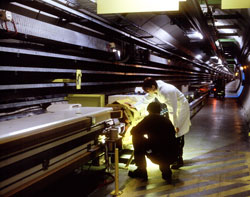The European Organisation for Nuclear Research–better known as CERN and home of the Large Hadron Collider–has implemented clustered NAS in its 2PB estate of NetApp filers.
The organisation switched on clustered NAS functionality in its NetApp devices this summer.Clustering,or scale-out network-attached storage(NAS),allows users to build grid-like clusters of NAS devices that can scale to provide further capacity or processing power,with all devices running a single massive file system.

This means hardware can be added and removed from the cluster without disruption,which was a major concern for deputy group leader for database services at CERN,Eric Grancher.
"It's a big advantage;clustering really matters to us,"said Grancher."Previously.we had to shut everything down if we needed to add or remove devices,and that was impossible when the accelerator was running.
Read more about NAS:Podcast:NAS management comes of age with clustered NAS NetApp FAS2220 turns the tide for clustered NAS Podcast:Why you need clustered NAS and why it is ideal for big data SGI adopts hybrid storage for clustered NAS Coraid's ZFS NAS launched,but clustering has to wait
"Now we can carry out maintenance without going offline.The other big benefit is being able to move data around.If one device is maxing out on,for example I/O,we can move data to another that is not being used so heavily."
CERN is famous as the home of the Large Hadron Collider(LHC),the most powerful particle accelerator in the world.LHC experiments create 600 million collisions per second,which is a raw data rate of 1 million GBps.
Earlier this year scientists working on the data discovered signs of a new particle consistent with the Higgs Boson,a particle believed to give all other particles mass and which had been anticipated for more than 50 years.
The organisation has a total of 1,964TB of data in NetApp filers.It has 22 FAS 3040s,10 FAS 3140s and 24 FAS 3240s running predominantly SATA drives.These devices comprise four nodes in the NetApp Data ONTAP cluster which support Oracle databases–including one with 4.1 trillion rows of data–running on HP servers via a 10 Gigabit Ethernet LAN.
Data held on the devices includes run-of-business items,such as HR and finance plus LHC technical documents and operational control data,but the vast bulk comprises experiment data that is added to at a rate of 50TB per year.
NetApp introduced clustering capability in version 8.1.1 of its storage operating system Data ONTAP earlier this year.The move marked the first time a top six storage supplier has implemented true NAS clustering in mainstream NAS products.
CERN's FAS 3240 filers each contain 512GB of Flash Cache to speed up reads from their SATA drives.Flash Cache is NetApp's implementation of solid-state flash technology.The company believes that flash should not be added as a storage tier,but that it should be used as cache-only.
CERN also uses Data ONTAP's compression and achieves reduction ratios of up to 3.5:1.





